![]()
![]()
![]()
Use LEFT and RIGHT arrow keys to navigate between flashcards;
Use UP and DOWN arrow keys to flip the card;
H to show hint;
A reads text to speech;
27 Cards in this Set
- Front
- Back
|
Stakeholders consequences of tax |
Taxes race prices Reduces output Market size shrinks Consumers and producers suffer Government benefits |
|
|
Consumer Tax Burden |
(P tax-Pe) x Q tax |
|
|
Producer Tax Burden |
(Pe-p1) x Q tax |
|
|
Total tax revenue |
(P tax-P1) x Q tax |
|
|
Draw Tax Graph |
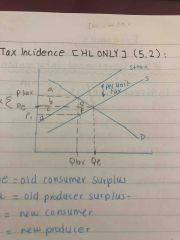
|
|
|
Why do government subsidize? |
To increase consumption by lowering the price. To support an industry by helping production costs. Make goods competitive on the world market when they lower costs enough. |
|
|
Draw Subsidies Graph |
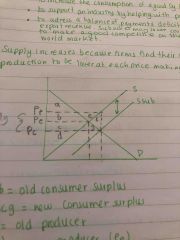
|
|
|
Price ceilings |
Maximum price set below the equilibrium price meant to help consumers afford it. |
|
|
Price Ceiling Graph |
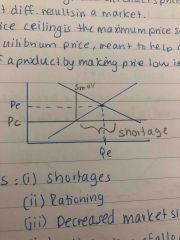
Back (Definition) |
|
|
Effects of Price Ceilings |
Shortages Rationing Decreased market size Elimination of allocative efficiency (MB=MC) Black markets |
|
|
Examples of Price Ceilings |
Rice bread and staple foods Rent control Housing subsidy to fix having shortages |
|
|
Examples of Price Ceilings |
Rice bread and staple foods Rent control Housing subsidy to fix having shortages |
|
|
Price floor |
Minimum price above equilibrium to artificially increase price |
|
|
Price Floor Graph |
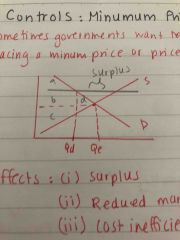
Back (Definition) |
|
|
Effects of Price Floors |
Surplus Reduced Market Size Cost inefficiency (higher production cost could be used for other things) Allocative efficiency and overproduction because MC>MB Informal markets (firms may illegally sell below limit) |
|
|
Effects of Price Floors |
Surplus Reduced Market Size Cost inefficiency (higher production cost could be used for other things) Allocative efficiency and overproduction because MC>MB Informal markets (firms may illegally sell below limit) |
|
|
Examples of Price Floors |
Agricultural Price Support Minimum wage Fixed prices (selling outside stadium) |
|
|
Indirect taxes |
Taxes placed on goods and services. They’re indirect because the government collects the revenue from the supplier after they’ve got it from the consumer. |
|
|
Indirect taxes |
Taxes placed on goods and services. They’re indirect because the government collects the revenue from the supplier after they’ve got it from the consumer. |
|
|
Types of tax |
Specific tax Ad Valorem tax |
|
|
Indirect taxes |
Taxes placed on goods and services. They’re indirect because the government collects the revenue from the supplier after they’ve got it from the consumer. |
|
|
Types of tax |
Specific tax Ad Valorem tax |
|
|
Specific tax |
Charge a specific amount to be paid for every unit of good sold and this is a parallel shift. |
|
|
Indirect taxes |
Taxes placed on goods and services. They’re indirect because the government collects the revenue from the supplier after they’ve got it from the consumer. |
|
|
Types of tax |
Specific tax Ad Valorem tax |
|
|
Specific tax |
Charge a specific amount to be paid for every unit of good sold and this is a parallel shift. |
|
|
Ad Valorem tax |
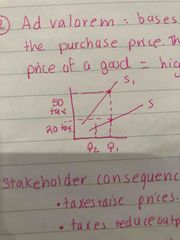
Bases the tax on a percentage of the purchase price. Therefore higher price if the good, the higher percentage. |

